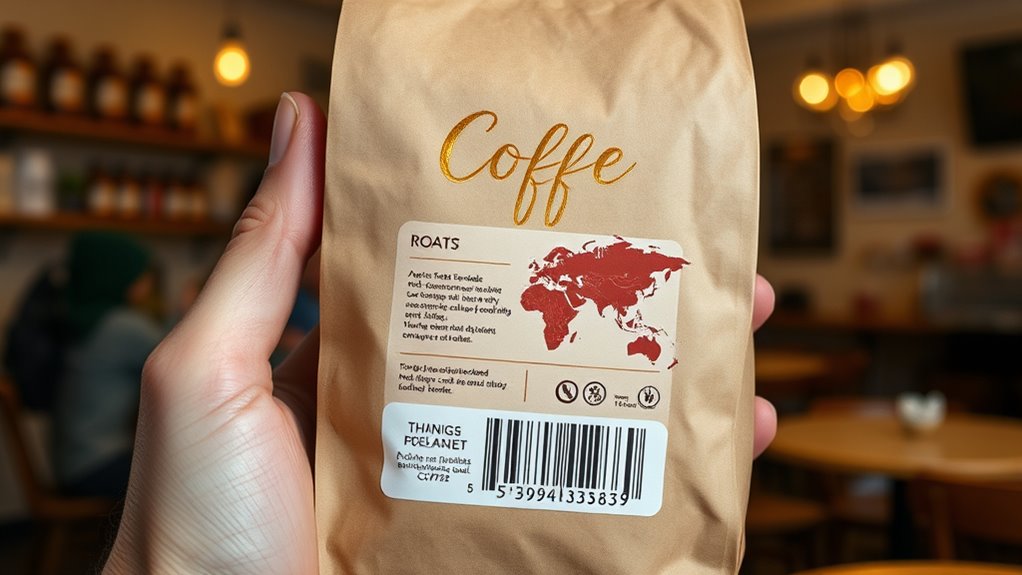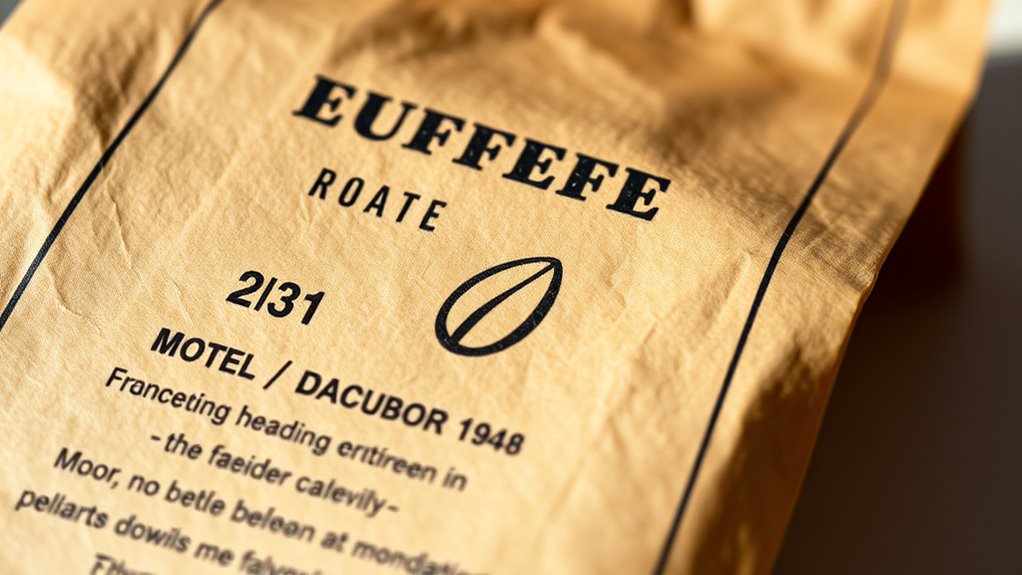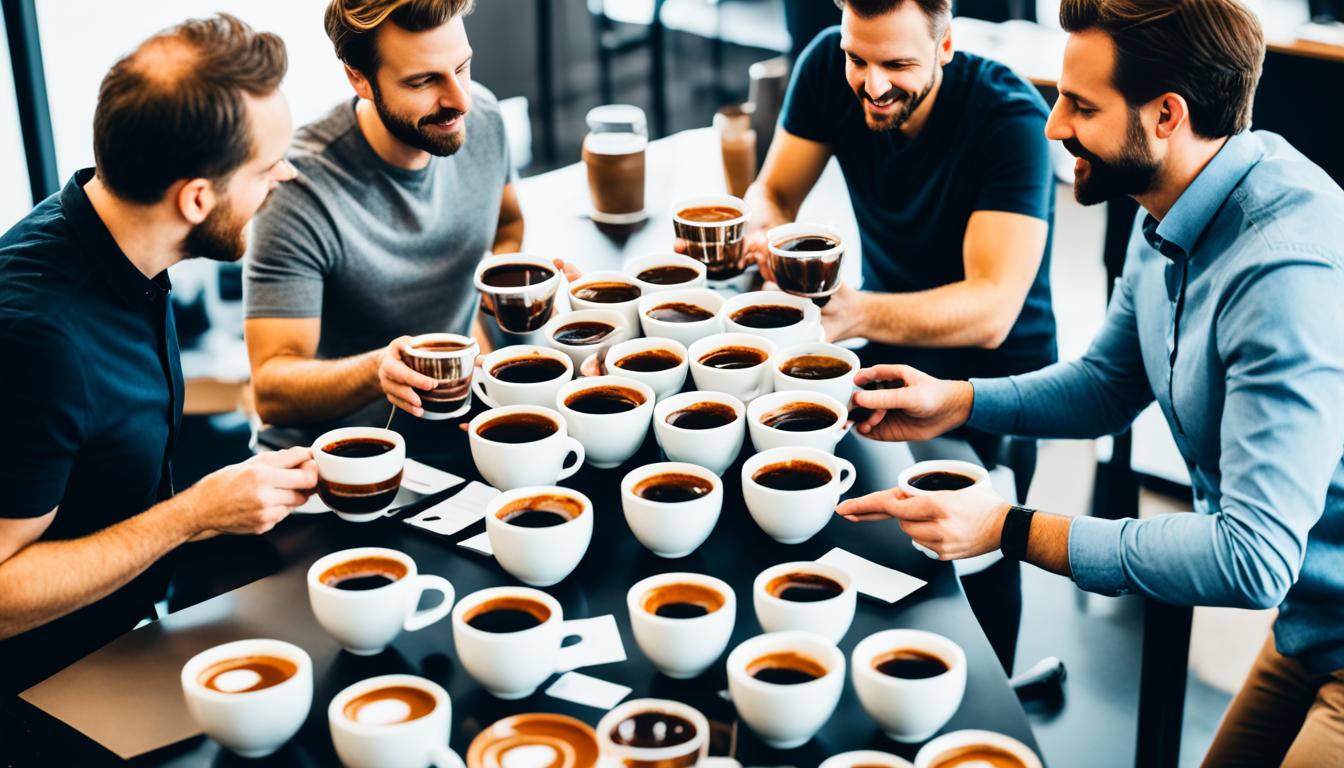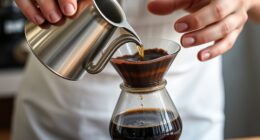When decoding coffee labels, start by checking the origin details like country and farm or cooperative, which reveal regional flavors such as fruity Ethiopian or chocolatey Colombian profiles. Look for certifications like Organic or Fair Trade to understand farming practices and ethical standards. Note the roast level—light, medium, or dark—to match your taste preference. Also, examine the flavor notes and processing methods, which influence aroma and taste. If you’re curious about how all these details come together, keep exploring.
Key Takeaways
- Check the origin details to understand regional flavor profiles and trace the coffee’s journey.
- Look for certifications like Organic or Fair Trade to ensure ethical and eco-friendly farming practices.
- Identify the roast level (Light, Medium, Dark) to match flavor preferences and aroma profiles.
- Review flavor notes to find primary tastes such as berry, chocolate, or citrus that suit your palate.
- Consider processing methods (washed, natural, honey) as they influence flavor complexity and sweetness.

When you pick up a bag of coffee, the labels can seem overwhelming, but they actually hold valuable clues to what’s inside. Decoding coffee labels helps you understand the story behind each cup, guiding you to choices that match your taste and values.
The first thing you’ll want to examine is the origin. Labels often specify the country, region, or even the specific farm or cooperative where the coffee was grown. This information is key to identifying regional profiles, as certain areas produce beans with distinct flavor profiles, such as bright citrus notes from Ethiopian highlands or chocolatey richness from Colombian estates. Recognizing these origin details allows you to trace the coffee’s journey and appreciate the unique characteristics tied to its terroir.
Next, look for certifications on the label. Certifications like Organic, Fair Trade, Rainforest Alliance, or Bird Friendly aren’t just badges—they represent ethical, environmental, and sustainable farming practices. Coffee bearing these certifications ensures that the farmers used eco-friendly methods, received fair compensation, and that the environment was protected during cultivation. By decoding these symbols, you’re supporting responsible sourcing and making more conscious choices.
The label also indicates the roast level, which directly influences your coffee experience. Whether it’s Light, Medium, or Dark, the roast level affects flavor development and aroma. Light roasts tend to preserve the beans’ original characteristics, showcasing bright, fruity, or floral notes. Medium roasts offer a balanced profile with hints of caramel and nuttiness, while Dark roasts bring a bold, smoky, or bittersweet flavor. Understanding this helps you select a coffee that aligns with your preferred flavor profile.
Flavor notes listed on the label serve as a sensory guide, highlighting the primary tastes you can expect. These notes—like berry, chocolate, spice, or citrus—assist you in choosing a coffee that suits your palate. Keep in mind that processing methods, such as washed, natural, or honey, influence these flavors and aromas. For example, naturally processed coffees often have fruitier, more pronounced sweetness, while washed coffees tend to be cleaner and brighter. Additionally, understanding processing methods can deepen your appreciation of how flavors develop and influence your coffee experience.
Frequently Asked Questions
How to Read a Coffee Label?
When you read a coffee label, start by noting the coffee’s name and origin, which tell you where it’s from and its unique characteristics.
Look for tasting notes like fruity or chocolatey flavors to understand its profile.
Check details such as region, farm, and processing methods to see how they influence taste.
This helps you choose coffee that matches your preferences and enhances your brewing experience.
How to Tell if Coffee Is High Quality?
When judging coffee quality, look for beans with a shiny, oily surface, indicating freshness. Check if the coffee is from high-altitude regions, which usually offer richer flavors. Certifications like Organic or Fair Trade show standards are met.
Also, detailed labels revealing origin, varietals, and processing methods help you identify quality. If the beans are uniform and well-roasted, you’re likely getting a high-quality brew.
What Is the 15-15-15 Coffee Rule?
The 15-15-15 coffee rule tells you to use about 15 grams of coffee with 15 ounces of water for a balanced brew.
You’re aiming for consistency and great flavor, especially in pour-over or drip methods.
If you want a stronger or milder cup, just adjust the coffee or water while keeping the ratio the same.
It’s a simple way to make your coffee taste just right every time.
What Are the FDA Requirements for Coffee Labeling?
The FDA requires coffee labels to include the product name, net weight, and contact info for the manufacturer or distributor.
If your coffee is flavored or processed, it must list ingredients if additives are used.
Organic coffee needs the USDA Organic seal, and labels must specify the country of origin, especially for single-origin products.
Any health claims or nutritional info must be truthful and backed by evidence.
Conclusion
By understanding what to look for on coffee labels, you can make smarter choices and enjoy your brew even more. Pay attention to the roast date, origin, and certifications to get the freshest and most authentic flavor. Don’t forget to factor in your taste preferences and brewing method. With this knowledge, you’ll confidently select coffees that suit your style and ensure every cup is satisfying. Happy sipping!









